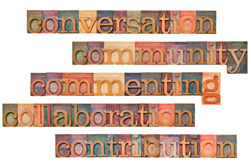What is an online community?

An online community, sometimes called a ‘virtual community’, is a group of like-minded individuals connected by online interactions. It’s members enable the existence of the community by sharing information and helping each other. Online communities can be found on forums, weblogs and social network sites. The theme of the community can be very diverse ranging from hobbies such as dogs, gadgets or fashion, life stage-oriented themes such as pregnancy or marriage, disease-related themes, to business topics such as marketing or technology.
Apart from the technologies used a community is not new. People have always formed groups around shared interests, usually also based on location. Interaction was social, face-to-face and in real life. The internet has enabled the formation of communities across countries and even continents. People find each other online and use communication tools such as chat, instant messaging, e-mail, forums and social networking sites.
Why is a community important for you as a business?
As a business you can participate in existing online communities or connect people and grow your own community. Key is to remember why people want to belong to a community. It’s about shared interests, to help and be helped, to get educated, informed or inspired, to get to know others that share the same values and interests and to extend their network of people.
You can build a community around your brand or around the theme in which your brand lives, your niche. This way you build connections with people that can be potential employees, clients, partners or investors. A community can facilitate crowd sourcing as you’ll also find subject-matter experts as members. A community can also facilitate lead generation as you’ll attract people who are interested in the subject. Either way facilitating a community in a specific niche makes you an expert and positions you as a thought leader.
Where do you start?
You know who you want to target, but now you must go and find out where they are. As people are already online this is where you start looking. Find who’s talking about what, identify the relevant people and focus first on the most vocal people or future advocates.
A common place to look first is Twitter and start building your community from there. This is how you build connections on this platform:
1. Find who’s talking about relevant subjects (you can use the hash tag in your twitter search).
2. Inspect their profile and if this looks interesting you follow them.
3. People will notice when you start following them, check you out and perhaps follow your back.
Repeating these steps will grow your list of followers. This way you are now building one-to-many connections. You connect people by offering and accepting. Offer information that is relevant to your theme. Answer questions that get asked in your timeline. Ask questions yourself and thank those who take the time to answer. Your Twitter followers are your candidate community members.
How to proceed building your community
Building an engaged list of followers is not a “one-and-done” type of activity. It takes consistent and regular participation. Once you have grown your reach the content you publish has a higher impact. It’s important to balance quantity and quality. You need a large following in order to make a difference but in order to make a difference you need the right kind of followers. This means you never stop inviting new people.
The next step is about connecting the members, so you get many-to-many connections which makes a real community. You’ll know you’re going in the right direction when you see people responding to each other and when they use each other’s screen names in their response. One way of enabling these many-to-many connections is to invite your Twitter followers to join a forum you own. Facebook groups present an alternative but it’s better to build on a platform that you own and control.
Appoint a community manager within your organization and allow him or her to immerse themselve in the community. Support should be in place as well as the resources required for the community member to find out what the users need. A common mistake is to have ultra-sensitive editors, who don’t understand social media, to dictate the message the community manager is allowed to spread.
The best communities cohere around leaders, the community managers, and the best inspire leadership in others. Reward those who contribute and help others. Responding and publicly acknowledging their contribution is a reward. Keep a list of the most active members and pro-actively ask for their opinion when you have started a new forum topic or published a new blog post. It’s quite a step going from ‘likes’ or ‘followers’ to ‘engaged ambassadors’. You need to nurture your community. Integrity and transparancy become nearly as important as authority. As time progresses, more information gets shared, people get helped, trust is build and your authority – and that of the the most active members – grows.
Nothing can take the place of dedication and persistence
Building an engaged online community takes time and effort, but it’s a valuable and strategic tool that can have a great return on investment with implications for knowledgebase ownership, customer satisfaction, customer loyalty, brand/PR management, recruitment, reach and lead generation.


Recent Comments